What is gilding and how quickly does it wear off?
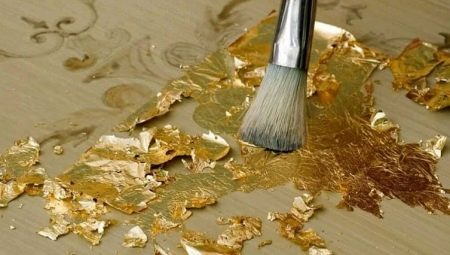
Gold adornments in the interior and jewelry are to the taste of many, but not everyone can purchase them. In order to save money, gilded items are often used instead of gold. The gilding technique originated several decades ago and remains in demand until modern days.
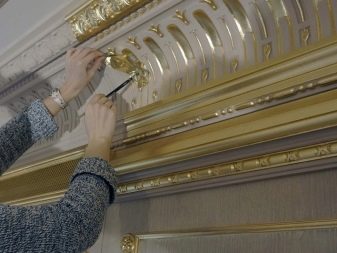
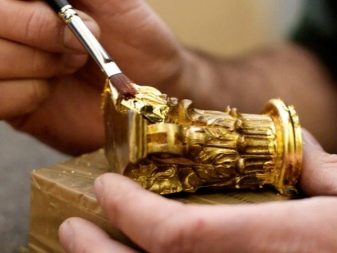
What it is?
Gilding is the coating of the surface with the thinnest layer of pure gold. The thickness can be 1-25 microns, while the thing acquires an impeccable resemblance to gold. The art of gilding originated in Ancient Egypt. It was in this country that the mining of the precious metal reached the level of industrial production for the first time. When the pharaoh owned all the mines, first of all, the household items of the ruling family were gilded.

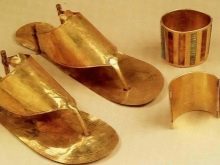

According to another version, the practice of gilding comes from China. But given the correlation of historical facts, the primacy in the introduction of gilding still belongs to Egypt. The discovered gilded sarcophagi are more than 5 thousand years old, and in the Chinese provincial city of Lao Tang (the birthplace of the gilding technique), the thinnest layers of gold have been produced for about 2 millennia.
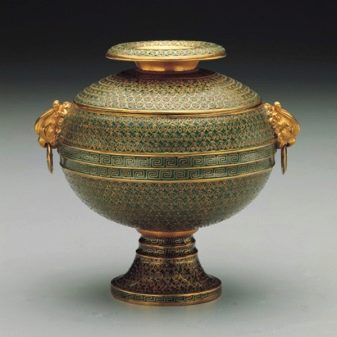

In Ancient Russia, the art of gilding received a strong impetus in development, stepping far forward. Gold gave the status of prestige and was revered as a divine symbol of believers. The popularity of gilding led to the creation of a school of gilding with the introduction of unique methods and subtleties of application. From an early age, masters taught boys all the intricacies of their craft. Few succeeded in reaching the heights of skill.
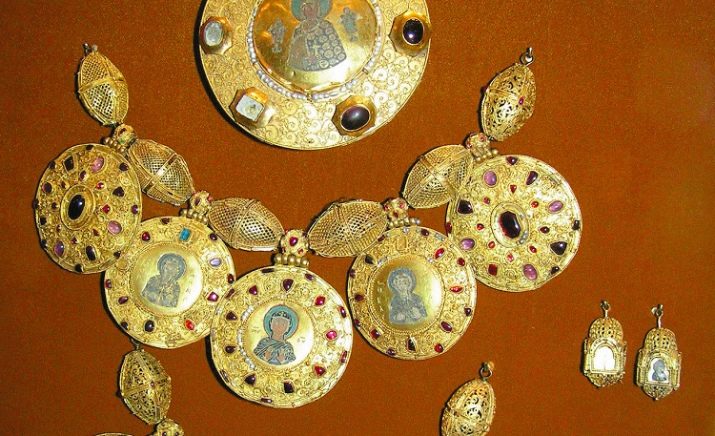
The next leap in the development of the original art of gilding was facilitated by architects, primarily Bartolomeo Rastrelli. The famous architect was the founder of the Baroque style with its characteristic gilded furniture and stucco. His contribution is significant in the history of gilding. In the 19th century, the Jacobi galvanic method was discovered, which facilitated gilding and made it much safer and more accessible.
Electroplating has taken gold plating to a new level.
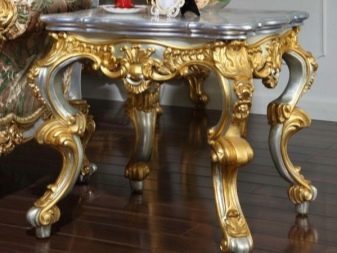
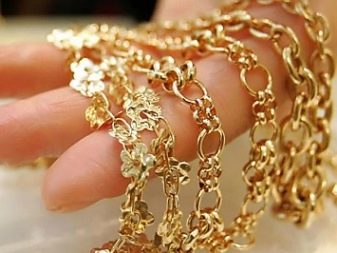
How is it different from gold?
The main difference between gilding and gold is composition. Visually, they are not always distinguishable, even from the point of view of a professional. The main advantage of gold jewelry is its durability, and the gilded layer wears off quickly. Moreover, gilding products are much cheaper. They are not made for everyday wear and need to be handled with care. The first differences are easy to notice in the store.
First of all, you need to carefully read the information on the product tag. Gold plated goods must be labeled gold with the prefix: filled, soldered or plated. They denote the way in which the gilding was applied to the item. For example, gold filled means electroplated plating, 1 micron thick gold-plated using 999-carat gold.

The top gold plated layer is easy to wipe off during the sanding process. After removing it, assay acid is applied to the surface of the object. This way you can easily identify the sample of the product or the metal present.
Besides, experts in pawnshops determine the value of products using low-traumatic needles. The sharp end makes a neat puncture on the inside of the jewelry. The needle is immersed to a thickness of 0.6 microns, which is invisible to the eye. The jeweler can then accurately assess the composition and value of the item.
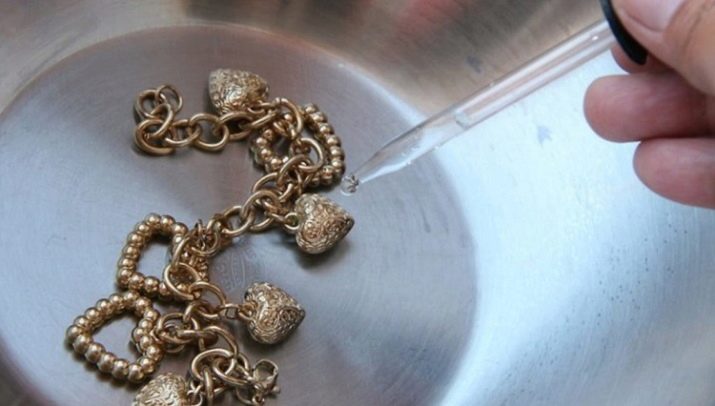
When buying non-certified gilded jewelry, it is important to first check for authenticity. The cost of a product depends on what percentage of gold it contains. You can acquire special reagents and independently examine the purchase for authenticity at home. In the absence of reagents, some simple manipulations will help in this matter.
This is a completely free verification option, but it is not known how effective it is. The decoration must be brought to the candle flame for 20 seconds. If dark spots and stains appear on the surface, the item is gilded.

The indisputable advantages of gilding are:
- affordable cost of products in comparison with gold analogues;
- presentable and unique look that looks identical to gold;
- the ability to emphasize status.
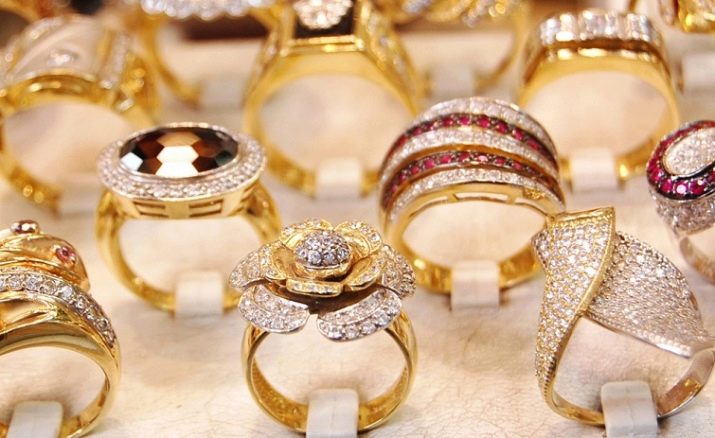
Basic properties
Gilding not only ennobles the appearance of the product, but also serves to protect the surface from oxidation and biocorrosion processes. Of course, the properties of the coating are primarily influenced by the thickness of the coating and the quality of the noble metal. How much the product will remain shiny depends on the thickness of the gilding application. Gold is a soft and malleable metal that wears quickly from the surface.
Therefore, it is not customary for designers of famous jewelry houses to make an extremely thin layer of gilding. Traditionally, modern products are covered with a layer of gilding 0.04-0.1 mm.
Compliance with the elementary care system will allow the product to please the eye and entertain the soul of the owners from 3 to 12 months.

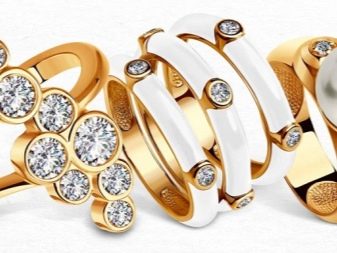
Modern jewelers work with different gilding, creating unusual colors by including other metals in the gold alloy. To get white, you need to combine the usual yellow gold with silver (less often nickel or palladium is used instead of silver). For a pinkish tint, a small percentage of copper is added to the alloy. The sample also affects the shade of gilding.
In European countries, it is traditional to use the 750th test to make the product yellow, and in Russia, the 585th test with a slight pinkish undertone is a priority. All jewelry, including gilded ones, must have a certified stamp. In the Russian jewelry industry, it is customary to put a stamp with the marking of the sample of the metal from which the product is made. On imported products, they put a sample of specifically gold plating in carats, with the addition of a letter designation. It indicates the method of covering the decoration.
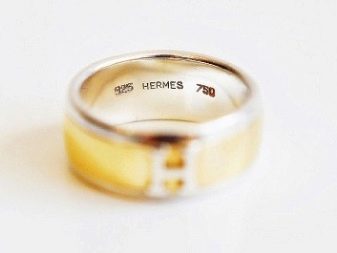
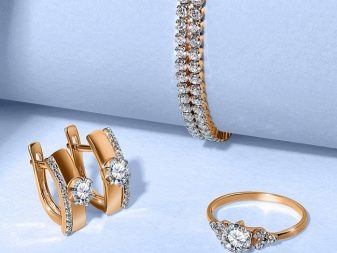
Species overview
The development of technology has led to the emergence of other methods of gilding. This made it possible to apply a thicker layer of gilding. The service life of such jewelry is much longer, but the cost is higher than with conventional gilding. The first to appear was the leaf gilding method - gold leaf. The technique is still used in interior decoration, food and cosmetic fields. The next technique was mercury. Heating the amalgam of gold and mercury had a negative effect on the body of the craftsmen. Therefore, this technology is currently practically not used.
Another method is electroplating. It is popular today and happens as follows: an object is immersed in a chemical solution and gold is applied to it using a current. The gilded layer is uniform, the thickness of the coating is easily determined. Modern scientists have not yet learned how to spray gold. Therefore, in this way nothing can be gilded. And in cans you can buy exclusively golden paint. The item covered with it will not be considered gilded and will not be marked. In recent years, the technique of gold leaf gilding has been in demand among decorators as a more accessible and cheaper method.
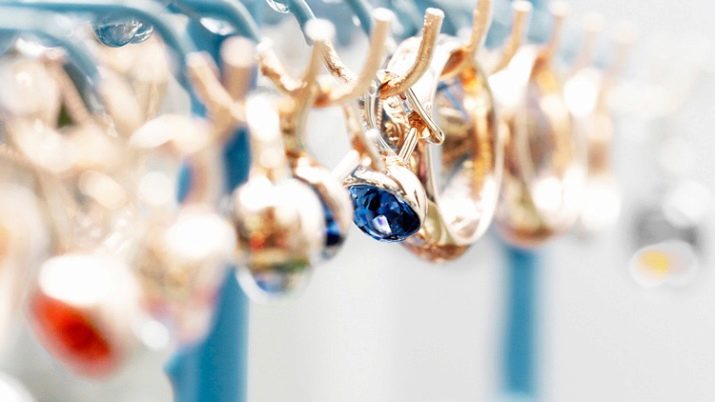
Gold leaf
This is the name of a thin sheet of metal marking of the 960th test. In Russia, gold leaf was traditionally used to cover domes on temples. In Russia, it is sold in the form of a bound book with 60 sheets each with an area of 10 cm2. There is no regulation for the thickness, but the most popular sheets are 10 times thinner than a human hair. They are used to decorate objects of art and in interior design. For outdoor decoration (fountains, statues) thicker sheets are used.
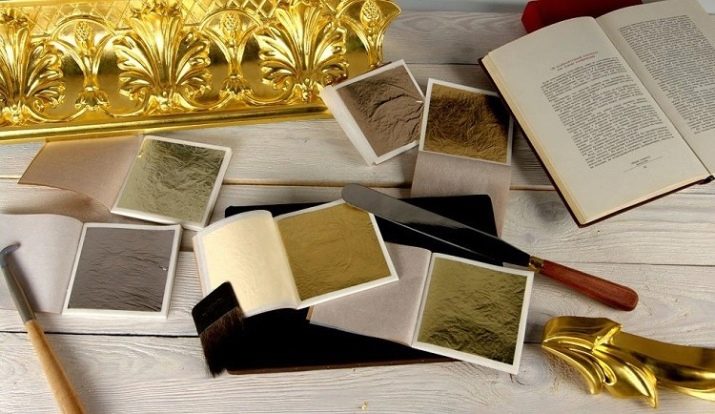
Potal
The famous gold leaf is replaced with soda. In appearance, these are gold layers or strips of an alloy of copper and zinc, and sometimes with the addition of aluminum. Potal imitates gold, silver or bronze. Layers can be with any pattern. The peculiarity of the potal lies in the fact that precious metal is not included in it. This has a positive effect on its price tag.
The main advantage lies in the relatively affordable cost of gold leaf with its spectacular appearance. In addition, gold plating protects the metal from corrosion, since gold does not oxidize. Gilding decorative elements does not darken over time and retains its visual appeal. The only drawback of gilding is its fragility.
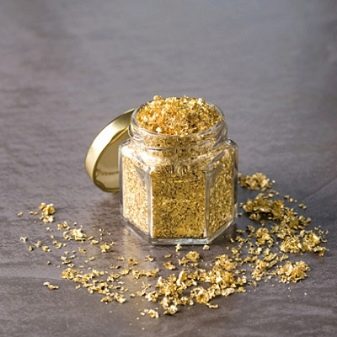
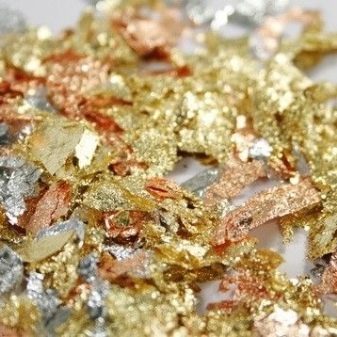
Application methods
The choice of the method determines, first of all, the quality of the surface and the level of professionalism of the performer.
- Fire or mercury. One of the first techniques used in gilding the domes of temples. Its essence was that not a harmless mixture based on mercury was used, which evaporates during the work. Due to the threat to the body and even the life of the performer, the method has remained in the past.
- Oil based. This method is also known as gilding with Mordan glue. It is used equally successfully for internal and external work. Mordan is available for purchase in Specialization Online Stores.
- Clay based. Gilding on polymer is suitable exclusively for covering wood and is not suitable for use in external decoration. This method is considered ancient and one of the most difficult and time-consuming, since rare and expensive components are required, for example, the addition of natural whale oil diluted in raw chicken egg white to the composition. There is no need to search for rare ingredients now. There are many ready-made formulations on sale.
- Garlic. An ancient way of applying gilding with freshly squeezed garlic juice. The dried surface was polished, then it was moistened and covered with a thin layer of gold sheets. Jewelers note a special brilliance with this method of gilding.
- Water-synthetic. Method using a mixture on water. The advantage is fast surface preparation.
The gilded product does not require final polishing, it turns out to be glossy already in the gilding process.
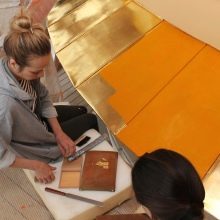


Where is it applied?
In modern days, copper and steel are gilded, gilding is used in jewelry, in art (decoration of old stucco molding, frames for painting, directly on canvases), in interior design, sculptures, in the manufacture of dishes (along the edge of wine glasses), automotive, dentistry and cosmetology, in the field of electronics (as guides). The use of gilding in cosmetology is a controversial issue.

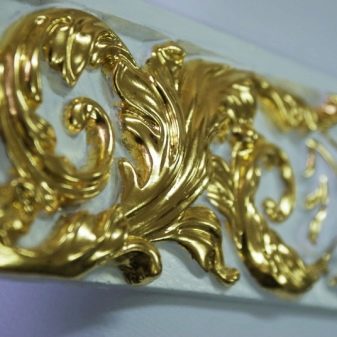
Someone thinks this method is a tricky marketing ploy of Russian cosmetologists. Despite this, Japanese specialists are busy refining the latest techniques for face gilding. The metal has the properties of enriching the epidermis with oxygen, preserving collagen in it and relieving irritation. Alternative medicine also has a separate anti-inflammatory direction using gilding - chrysotherapy.
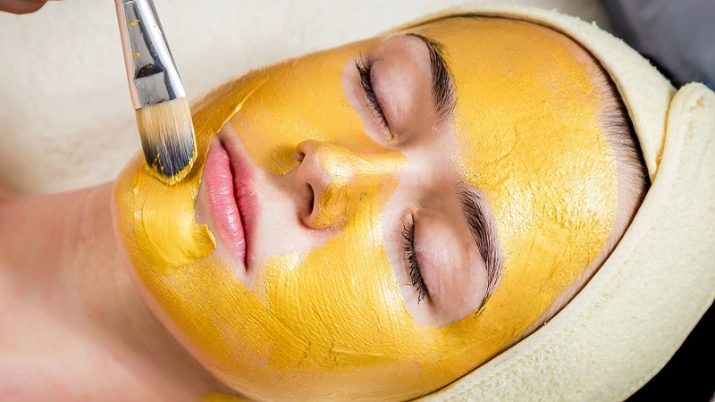
How long does it last?
The gilding wears off rather quickly. Therefore, it is preferable to apply it on items that are intended for beauty and are rarely used. Gilded jewelry is not very much in demand, because even if such a thing is worn neatly, it will wear off over time. Moreover, the top layer needs constant care. Over time, scratches and other traces of mechanical damage inevitably appear on the surface. The product will have to be gilded again over time.
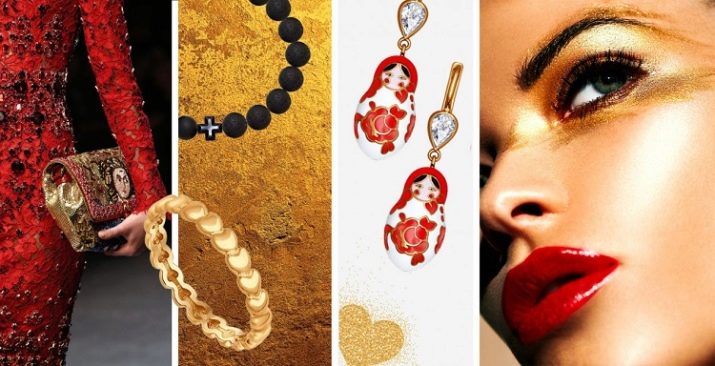
How to care for gold plated items?
So that the gilding on the jewelry does not darken soon, you must follow some rules for caring for the product.
- Wearing. It is imperative to remove gilded jewelry before showering, swimming pool, before washing dishes, etc. Avoid contact of gilding with sweat and cosmetic compounds. Remember that everyday wear will shorten the life of the product. A clear varnish can be applied to the surface to protect against darkening and corrosion.
- Storage. It is worth storing gilded jewelry in a separate compartment in a box or in cloth bags, avoiding contact with other items.
- Cleaning. For this purpose, only soft matter is suitable, chemicals and abrasives are excluded. Dark stains can be removed by wiping with regular vinegar, ammonia, or beer. After such a manipulation, the thing must be rinsed in water.
The luster of tarnished jewelry can bring back the raw egg white. Once a year, it is advisable to clean the products by a jeweler. You can also update the coverage there.
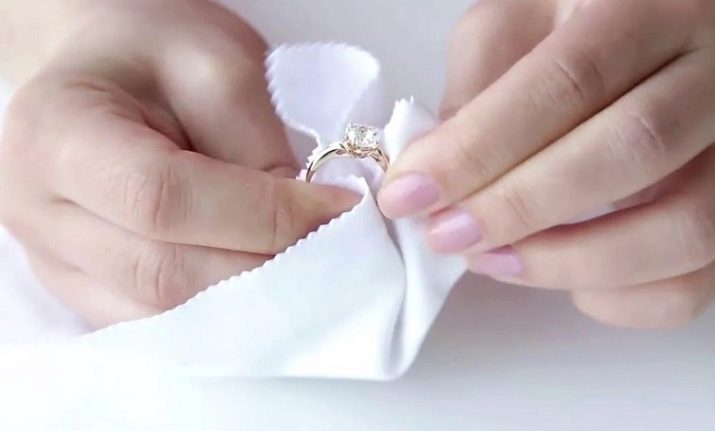
In the next video, you will see the application of gold plating on a silver chain.








